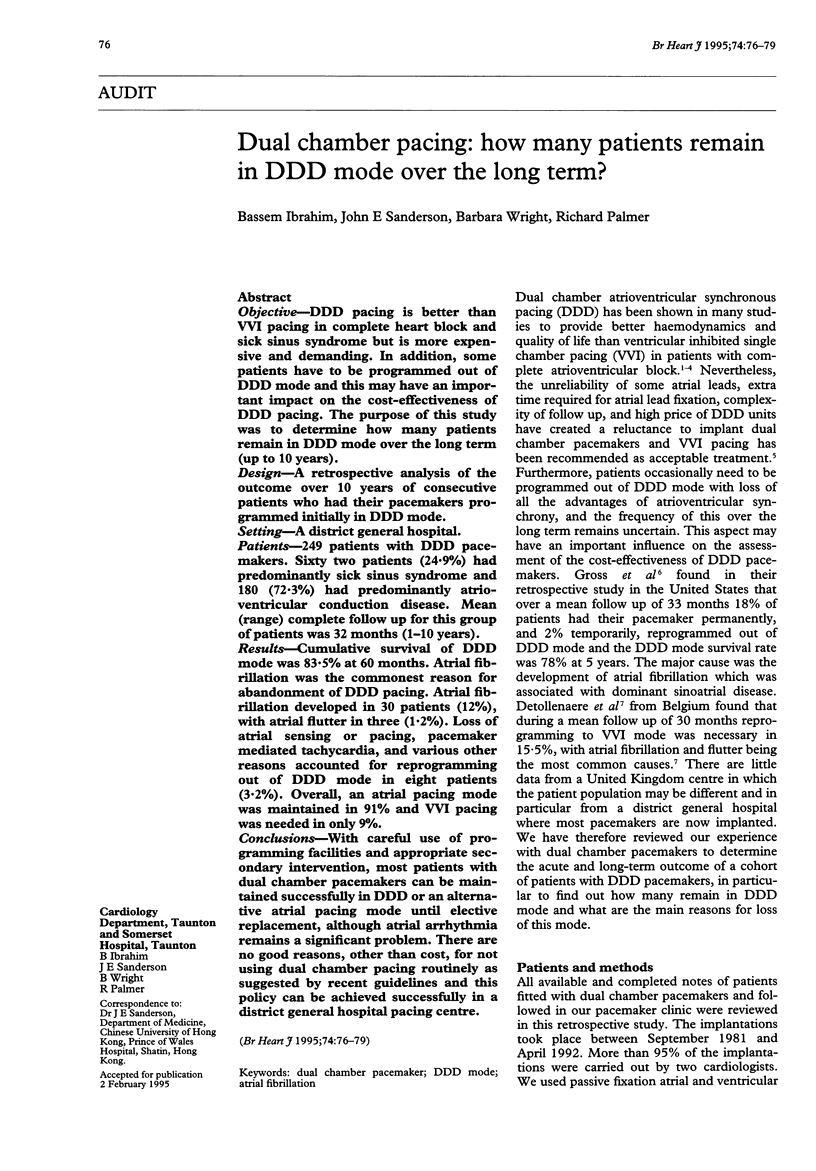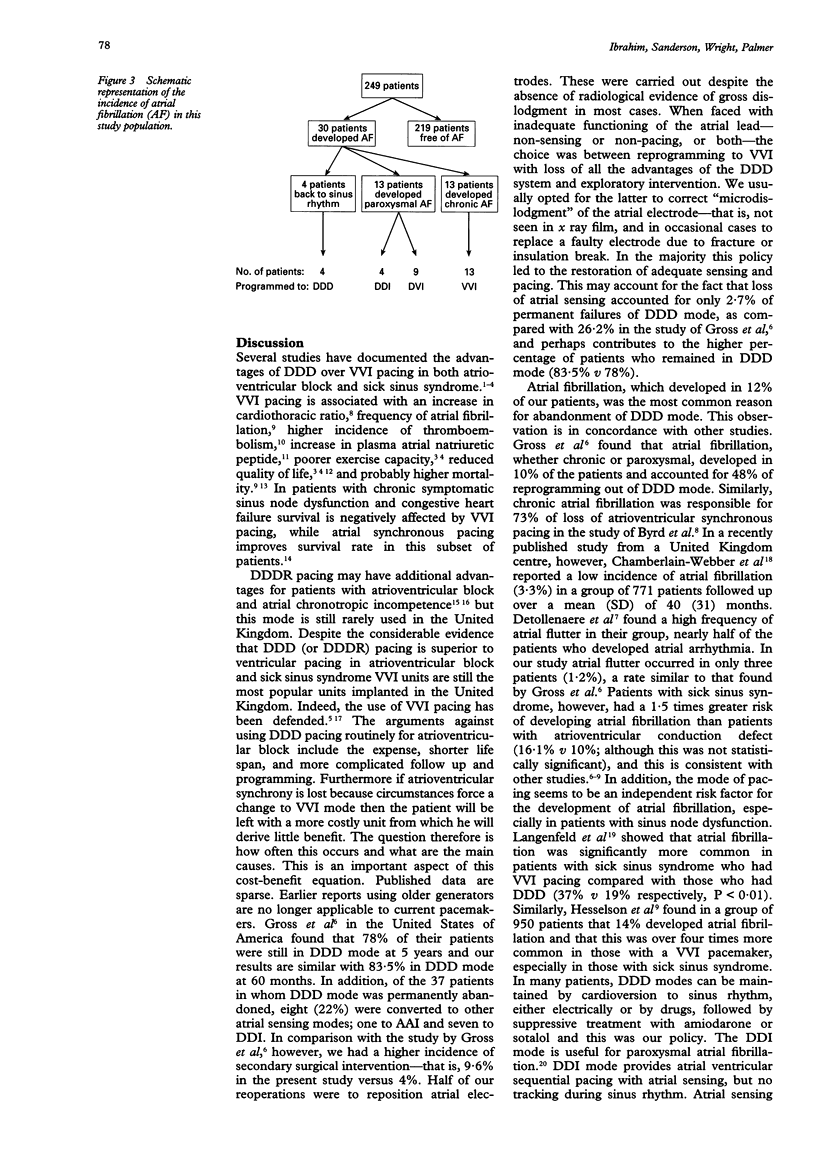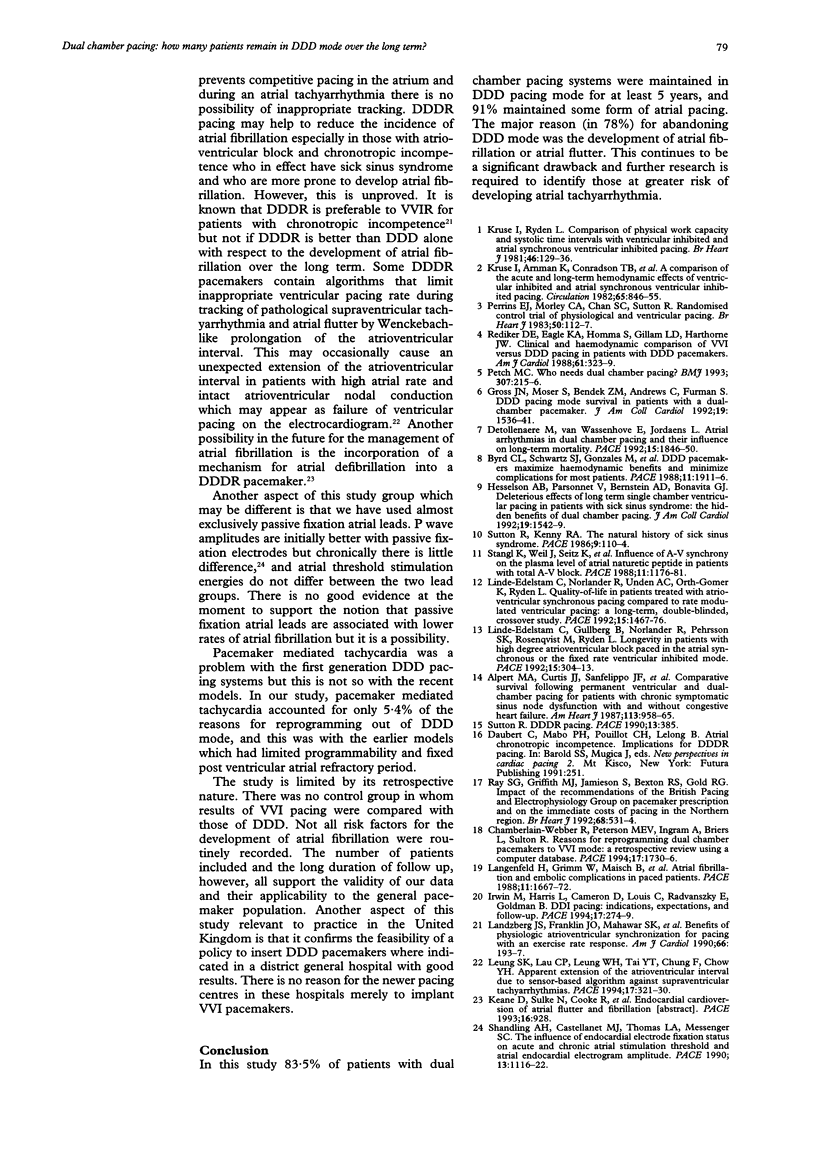Abstract
OBJECTIVE--DDD pacing is better than VVI pacing in complete heart block and sick sinus syndrome but is more expensive and demanding. In addition, some patients have to be programmed out of DDD mode and this may have an important impact on the cost-effectiveness of DDD pacing. The purpose of this study was to determine how many patients remain in DDD mode over the long term (up to 10 years). DESIGN--A retrospective analysis of the outcome over 10 years of consecutive patients who had their pacemakers programmed initially in DDD mode. SETTING--A district general hospital. PATIENTS--249 patients with DDD pacemakers. Sixty two patients (24.9%) had predominantly sick sinus syndrome and 180 (72.3%) had predominantly atrioventricular conduction disease. Mean (range) complete follow up for this group of patients was 32 months (1-10 years). RESULTS--Cumulative survival of DDD mode was 83.5% at 60 months. Atrial fibrillation was the commonest reason for abandonment of DDD pacing. Atrial fibrillation developed in 30 patients (12%), with atrial flutter in three (1.2%). Loss of atrial sensing or pacing, pacemaker mediated tachycardia, and various other reasons accounted for reprogramming out of DDD mode in eight patients (3.2%). Overall, an atrial pacing mode was maintained in 91% and VVI pacing was needed in only 9%. CONCLUSIONS--With careful use of programming facilities and appropriate secondary intervention, most patients with dual chamber pacemakers can be maintained successfully in DDD or an alternative atrial pacing mode until elective replacement, although atrial arrhythmia remains a significant problem. There are no good reasons, other than cost, for not using dual chamber pacing routinely as suggested by recent guidelines and this policy can be achieved successfully in a district general hospital pacing centre.
Full text
PDF



Selected References
These references are in PubMed. This may not be the complete list of references from this article.
- Alpert M. A., Curtis J. J., Sanfelippo J. F., Flaker G. C., Walls J. T., Mukerji V., Villarreal D., Katti S. K., Madigan N. P., Morgan R. J. Comparative survival following permanent ventricular and dual-chamber pacing for patients with chronic symptomatic sinus node dysfunction with and without congestive heart failure. Am Heart J. 1987 Apr;113(4):958–965. doi: 10.1016/0002-8703(87)90057-3. [DOI] [PubMed] [Google Scholar]
- Byrd C. L., Schwartz S. J., Gonzales M., Byrd C. B., Ciraldo R. J., Sivina M., Yahr W. Z., Greenberg J. J. DDD pacemakers maximize hemodynamic benefits and minimize complications for most patients. Pacing Clin Electrophysiol. 1988 Nov;11(11 Pt 2):1911–1916. doi: 10.1111/j.1540-8159.1988.tb06328.x. [DOI] [PubMed] [Google Scholar]
- Chamberlain-Webber R., Petersen M. E., Ingram A., Briers L., Sutton R. Reasons for reprogramming dual chamber pacemakers to VVI mode: a retrospective review using a computer database. Pacing Clin Electrophysiol. 1994 Nov;17(11 Pt 1):1730–1736. doi: 10.1111/j.1540-8159.1994.tb03739.x. [DOI] [PubMed] [Google Scholar]
- Detollenaere M., van Wassenhove E., Jordaens L. Atrial arrhythmias in dual chamber pacing and their influence on long-term mortality. Pacing Clin Electrophysiol. 1992 Nov;15(11 Pt 2):1846–1850. doi: 10.1111/j.1540-8159.1992.tb02980.x. [DOI] [PubMed] [Google Scholar]
- Gross J. N., Moser S., Benedek Z. M., Andrews C., Furman S. DDD pacing mode survival in patients with a dual-chamber pacemaker. J Am Coll Cardiol. 1992 Jun;19(7):1536–1541. doi: 10.1016/0735-1097(92)90615-t. [DOI] [PubMed] [Google Scholar]
- Hesselson A. B., Parsonnet V., Bernstein A. D., Bonavita G. J. Deleterious effects of long-term single-chamber ventricular pacing in patients with sick sinus syndrome: the hidden benefits of dual-chamber pacing. J Am Coll Cardiol. 1992 Jun;19(7):1542–1549. doi: 10.1016/0735-1097(92)90616-u. [DOI] [PubMed] [Google Scholar]
- Irwin M., Harris L., Cameron D., Louis C., Radvanszky E., Goldman B. DDI pacing: indications, expectations, and follow-up. Pacing Clin Electrophysiol. 1994 Mar;17(3 Pt 1):274–279. doi: 10.1111/j.1540-8159.1994.tb01388.x. [DOI] [PubMed] [Google Scholar]
- Kruse I., Arnman K., Conradson T. B., Rydén L. A comparison of the acute and long-term hemodynamic effects of ventricular inhibited and atrial synchronous ventricular inhibited pacing. Circulation. 1982 May;65(5):846–855. doi: 10.1161/01.cir.65.5.846. [DOI] [PubMed] [Google Scholar]
- Kruse I., Rydén L. Comparison of physical work capacity and systolic time intervals with ventricular inhibited and atrial synchronous ventricular inhibited pacing. Br Heart J. 1981 Aug;46(2):129–136. doi: 10.1136/hrt.46.2.129. [DOI] [PMC free article] [PubMed] [Google Scholar]
- Landzberg J. S., Franklin J. O., Mahawar S. K., Himelman R. B., Botvinick E. H., Schiller N. B., Springer M. J., Griffin J. C. Benefits of physiologic atrioventricular synchronization for pacing with an exercise rate response. Am J Cardiol. 1990 Jul 15;66(2):193–197. doi: 10.1016/0002-9149(90)90587-q. [DOI] [PubMed] [Google Scholar]
- Langenfeld H., Grimm W., Maisch B., Kochsiek K. Atrial fibrillation and embolic complications in paced patients. Pacing Clin Electrophysiol. 1988 Nov;11(11 Pt 2):1667–1672. doi: 10.1111/j.1540-8159.1988.tb06292.x. [DOI] [PubMed] [Google Scholar]
- Leung S. K., Lau C. P., Leung W. H., Tai Y. T., Chung F., Chow Y. H. Apparent extension of the atrioventricular interval due to sensor-based algorithm against supraventricular tachyarrhythmias. Pacing Clin Electrophysiol. 1994 Mar;17(3 Pt 1):321–330. doi: 10.1111/j.1540-8159.1994.tb01394.x. [DOI] [PubMed] [Google Scholar]
- Linde-Edelstam C., Gullberg B., Norlander R., Pehrsson S. K., Rosenqvist M., Rydén L. Longevity in patients with high degree atrioventricular block paced in the atrial synchronous or the fixed rate ventricular inhibited mode. Pacing Clin Electrophysiol. 1992 Mar;15(3):304–313. doi: 10.1111/j.1540-8159.1992.tb06500.x. [DOI] [PubMed] [Google Scholar]
- Linde-Edelstam C., Nordlander R., Undén A. L., Orth-Gomér K., Rydén L. Quality-of-life in patients treated with atrioventricular synchronous pacing compared to rate modulated ventricular pacing: a long-term, double-blind, crossover study. Pacing Clin Electrophysiol. 1992 Oct;15(10 Pt 1):1467–1476. doi: 10.1111/j.1540-8159.1992.tb02920.x. [DOI] [PubMed] [Google Scholar]
- Perrins E. J., Morley C. A., Chan S. L., Sutton R. Randomised controlled trial of physiological and ventricular pacing. Br Heart J. 1983 Aug;50(2):112–117. doi: 10.1136/hrt.50.2.112. [DOI] [PMC free article] [PubMed] [Google Scholar]
- Petch M. C. Who needs dual chamber pacing? BMJ. 1993 Jul 24;307(6898):215–216. doi: 10.1136/bmj.307.6898.215. [DOI] [PMC free article] [PubMed] [Google Scholar]
- Ray S. G., Griffith M. J., Jamieson S., Bexton R. S., Gold R. G. Impact of the recommendations of the British Pacing and Electrophysiology Group on pacemaker prescription and on the immediate costs of pacing in the Northern Region. Br Heart J. 1992 Nov;68(5):531–534. doi: 10.1136/hrt.68.11.531. [DOI] [PMC free article] [PubMed] [Google Scholar]
- Rediker D. E., Eagle K. A., Homma S., Gillam L. D., Harthorne J. W. Clinical and hemodynamic comparison of VVI versus DDD pacing in patients with DDD pacemakers. Am J Cardiol. 1988 Feb 1;61(4):323–329. doi: 10.1016/0002-9149(88)90938-1. [DOI] [PubMed] [Google Scholar]
- Shandling A. H., Castellanet M. J., Thomas L. A., Messenger J. C. The influence of endocardial electrode fixation status on acute and chronic atrial stimulation threshold and atrial endocardial electrogram amplitude. Pacing Clin Electrophysiol. 1990 Sep;13(9):1116–1122. doi: 10.1111/j.1540-8159.1990.tb02168.x. [DOI] [PubMed] [Google Scholar]
- Sutton R. DDDR pacing. Pacing Clin Electrophysiol. 1990 Apr;13(4):385–387. doi: 10.1111/j.1540-8159.1990.tb02051.x. [DOI] [PubMed] [Google Scholar]


